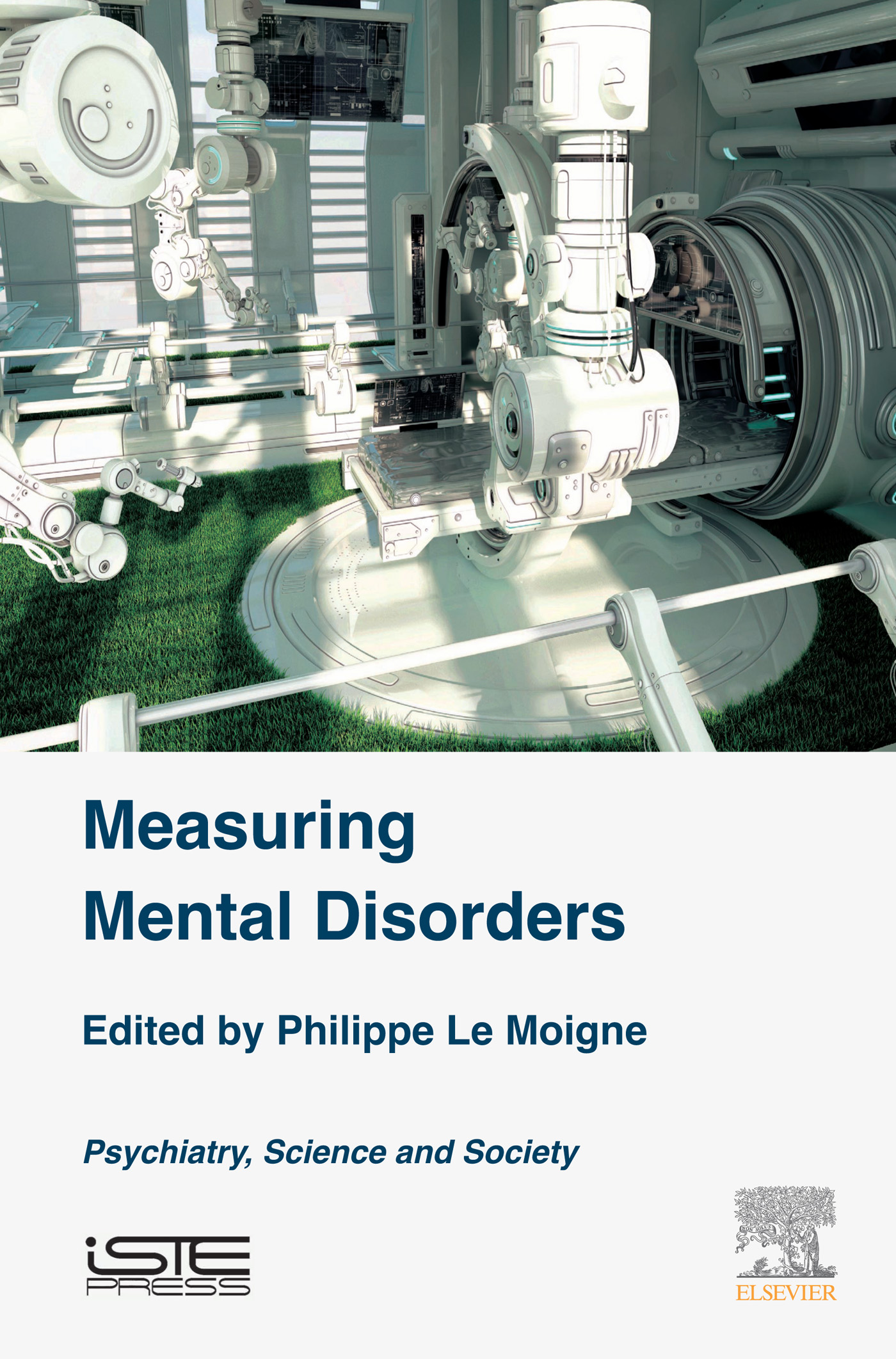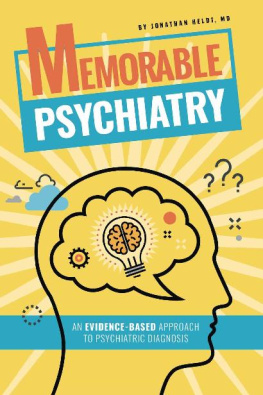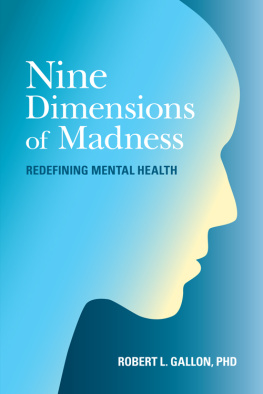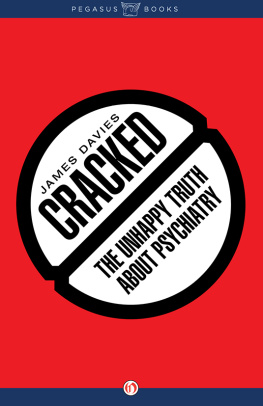Le Moigne - Measuring mental disorders: psychiatry, science and society
Here you can read online Le Moigne - Measuring mental disorders: psychiatry, science and society full text of the book (entire story) in english for free. Download pdf and epub, get meaning, cover and reviews about this ebook. City: London, year: 2018, publisher: ISTE Press Limited - Elsevier Incorporated;ISTE Ltd, genre: Religion. Description of the work, (preface) as well as reviews are available. Best literature library LitArk.com created for fans of good reading and offers a wide selection of genres:
Romance novel
Science fiction
Adventure
Detective
Science
History
Home and family
Prose
Art
Politics
Computer
Non-fiction
Religion
Business
Children
Humor
Choose a favorite category and find really read worthwhile books. Enjoy immersion in the world of imagination, feel the emotions of the characters or learn something new for yourself, make an fascinating discovery.

Measuring mental disorders: psychiatry, science and society: summary, description and annotation
We offer to read an annotation, description, summary or preface (depends on what the author of the book "Measuring mental disorders: psychiatry, science and society" wrote himself). If you haven't found the necessary information about the book — write in the comments, we will try to find it.
Le Moigne: author's other books
Who wrote Measuring mental disorders: psychiatry, science and society? Find out the surname, the name of the author of the book and a list of all author's works by series.
Measuring mental disorders: psychiatry, science and society — read online for free the complete book (whole text) full work
Below is the text of the book, divided by pages. System saving the place of the last page read, allows you to conveniently read the book "Measuring mental disorders: psychiatry, science and society" online for free, without having to search again every time where you left off. Put a bookmark, and you can go to the page where you finished reading at any time.
Font size:
Interval:
Bookmark:

Philippe Le Moigne
Health Industrialization Set
coordinated by
Bruno Salgues
Edited by


First published 2018 in Great Britain and the United States by ISTE Press Ltd and Elsevier Ltd
Apart from any fair dealing for the purposes of research or private study, or criticism or review, as permitted under the Copyright, Designs and Patents Act 1988, this publication may only be reproduced, stored or transmitted, in any form or by any means, with the prior permission in writing of the publishers, or in the case of reprographic reproduction in accordance with the terms and licenses issued by the CLA. Enquiries concerning reproduction outside these terms should be sent to the publishers at the undermentioned address:
ISTE Press Ltd
2737 St Georges Road
London SW19 4EU
UK
www.iste.co.uk
Elsevier Ltd
The Boulevard, Langford Lane
Kidlington, Oxford, OX5 1GB
UK
www.elsevier.com
Notices
Knowledge and best practice in this field are constantly changing. As new research and experience broaden our understanding, changes in research methods, professional practices, or medical treatment may become necessary.
Practitioners and researchers must always rely on their own experience and knowledge in evaluating and using any information, methods, compounds, or experiments described herein. In using such information or methods they should be mindful of their own safety and the safety of others, including parties for whom they have a professional responsibility.
To the fullest extent of the law, neither the Publisher nor the authors, contributors, or editors, assume any liability for any injury and/or damage to persons or property as a matter of products liability, negligence or otherwise, or from any use or operation of any methods, products, instructions, or ideas contained in the material herein.
For information on all our publications visit our website at http://store.elsevier.com/
ISTE Press Ltd 2018
The rights of Philippe Le Moigne to be identified as the author of this work has been asserted by him in accordance with the Copyright, Designs and Patents Act 1988.
British Library Cataloguing-in-Publication Data
A CIP record for this book is available from the British Library
Library of Congress Cataloging in Publication Data
A catalog record for this book is available from the Library of Congress
ISBN 978-1-78548-305-9
Printed and bound in the UK and US
Philippe Le Moigne
This objective of this book is to detail, through the lens of the social sciences, how and why the popularity of psychiatric measures has soared since 1980. This was when the first dedicated publication in the field the Diagnostic and Statistical Manual of Mental Disorders Third Edition (DSM-III) ().
In the following discussion on the assessment tools, we first examine scales or tests, that is observation scales or questionnaires primarily meant for diagnosing patients, or again, used to measure changes as they undergo therapy. This book thus explores the understanding of the principles behind, and the use of, these scales, with the exception of the last chapter, which focuses on a biological test used for screening for drug use in the workplace. These scales may include multiple items with ratings or may be reduced to a list that summarizes some elements of observation, as in the case of the Mini Mental State Examination (MMSE), used when screening for Alzheimers disease ().
Beyond these differences in form, it must be recognized that these scales or tests are, today, an obligatory step in research, so much so, in fact, that they keep increasing in number as the investigations into mental disorders have multiplied. Thus, these tests are applicable to the diagnosis of disorders such as depression, schizophrenia and personality disorders, as well as to the measure of how autonomous or functional a person with the disorder is, or again, to the definition of best practices in caring for patients. This expansion was not confined only to the science sector or professional practice: it spread to most areas of social life to such an extent that it has acquired a vehicular or matrix form.
Consequently, these instruments are also used for actuarial computations, reimbursement for care, hospital management, forensic expertise (). How do we explain the matrix style characteristic of these tools? And to what can it be attributed?
Taking a detour to look at how research work is organized may offer us an initial part of the response. If we remain within this sphere of activity, a clearly outdated vision of the role that these instruments play in research tends to attribute to them the status of a simple technical mediation between theoretical thought and its confrontation with fact. Seen in this light, the instrument is, at best, a useful tool for demonstrating a hypothesis. This rationalism remains, at the least, abstract and powerless when it comes to describing ongoing research, its organization of work and its historical development. As the sociology of science has shown us, one cannot imagine the expansion of this field of activity, starting from the 1960s, without the role played by the formalization and diffusion of generic tools in research (). This is why we cannot reduce the use of these instruments to prove a conceptual idea. This instrument is itself based on practical reasoning, endowed with rationalizations and references unique to it, while always being more or less grounded, that is considered from the constraints and the feasibility of scientific activity and from the pragmatic experience of the researchers.
However, while these tools played an undeniable role in the sciences, this does not lead, a contrario , to the deduction of a positive or apologetic history of instrumentation. Such a development leads to placing the instrument in the crucible of objective science, a credo behind which the authors of the DSM-III did not hesitate to rally (.
And again, these discussions on principles do not justify the diversity in both the scientific nature of the research instruments as well as the audience addressed by the research instruments. In order to take this into account, a broader vision of the use of these instruments is needed. Thus, in certain cases, the instruments relate a virtuous process at the end of which the use of the tools born of the scientific activity seem to respond to a sort of evidence; their use has been approved by research, while they find numerous applications in society. For instance, the series of examples described by Terry Shinn of automatic control systems, ultracentrifuge systems, laser systems or, again, microprocessor systems (). In other cases, the assessment tools may testify to the relations between opposing forces, its conceptual and factual pertinence may be debated (if not roundly criticized) without this disaccord resulting in its use being challenged either in research or in its applications in society. To summarize: in this example, the use of the instrument represents a form of compromise; this use is judged acceptable or even practical, without the form being completely approved. But how can we explain its continued use if it does not win adherents? Such a situation may be imagined into probability when we can distinguish the intrinsic quality of the tools from their organizational properties. In other words, it may be that certain tools continue to be employed despite the criticism leveled at their use, simply by virtue of the regulation and stabilizing effects they bring about. For example, if using this tool validates the position of the research sector that designed the instruments, of the professionals who keep turning to it, as well as of all or a large part of their clientele, then this is enough to maintain the distribution of these tools, even though there is no unanimous view as to their use. And thus, this specific case offers quite a good description of the status of measurements in the field of psychiatric research and activity.
Font size:
Interval:
Bookmark:
Similar books «Measuring mental disorders: psychiatry, science and society»
Look at similar books to Measuring mental disorders: psychiatry, science and society. We have selected literature similar in name and meaning in the hope of providing readers with more options to find new, interesting, not yet read works.
Discussion, reviews of the book Measuring mental disorders: psychiatry, science and society and just readers' own opinions. Leave your comments, write what you think about the work, its meaning or the main characters. Specify what exactly you liked and what you didn't like, and why you think so.











